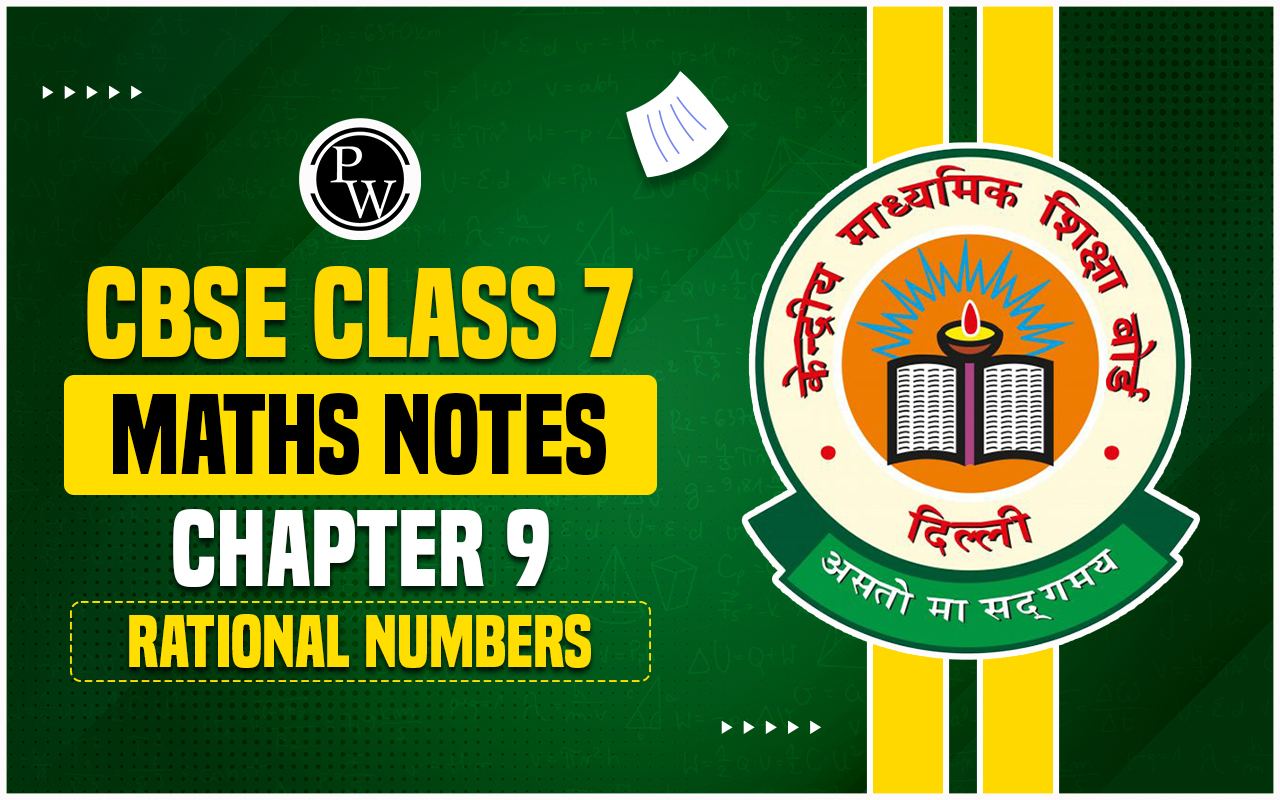

CBSE Class 7 Maths Notes Chapter 9
CBSE Class 7 Maths Notes Chapter 9 Rational Numbers: A rational number in math is any number that can be written as a fraction, where the denominator (the bottom number) is not zero. This includes fractions where both the numerator (top number) and denominator are integers (whole numbers).
When we divide a rational number, the result can be a decimal that either ends or repeats. In this article, we'll discuss what rational numbers are, their properties and forms, and the difference between rational and irrational numbers. We'll also work through some examples to help understand the concepts better. To plot rational numbers on a number line, we need to simplify them and express them as decimals. The Revision Notes for Class 7 Maths Chapter 9 are designed based on the NCERT curriculum by experts at Physics Wallh. These notes provide step-by-step solutions, highlighting important formulas and shortcuts. They are created to help students understand concepts faster and more effectively. .CBSE Class 7 Maths Notes Chapter 9 Rational Numbers PDF
You can access the PDF of CBSE Class 7 Maths Chapter 9 Rational Numbers Notes through the provided link below. These notes cover important topics related to rational numbers, helping you understand how to work with them effectively. From understanding the basics to performing operations and solving problems, these notes provide a comprehensive overview of the chapter. Whether you're studying for exams or simply looking to strengthen your math skills, these notes are a valuable resource.CBSE Class 7 Maths Notes Chapter 9 Rational Numbers PDF
CBSE Class 7 Maths Notes Chapter 9 Rational Numbers
What is a Rational Number?
A rational number is a type of number that can be expressed as the quotient or fraction of two integers, where the denominator (the bottom number) is not zero. In other words, it's any number that can be written in the form of p/q, where p and q are integers and q is not equal to zero. Rational numbers can include whole numbers, integers, and fractions. For example, 1/2, 5, and -3/4 are all examples of rational numbers.Types of Rational Numbers
There are two main types of rational numbers based on the signs of their numerators and denominators:- Positive Rational Numbers : These are rational numbers where both the numerator and denominator are either positive or negative. For example, 2/3, -4/5, and 7/-8 are positive rational numbers.
- Negative Rational Numbers : These are rational numbers where the numerator and denominator have opposite signs. For instance, -3/4, 5/-6, and -8/7 are negative rational numbers.
| CBSE Syllabus Class 7 | |
| CBSE Class 7 English Syllabus | CBSE Class 7 Math Syllabus |
| CBSE Class 7 Social Science Syllabus | CBSE Class 7 Science Syllabus |
Equivalent Rational Numbers
Equivalent rational numbers are numbers that have the same overall value but are represented differently. In other words, they are different fractions that represent the same portion of a whole. To find equivalent rational numbers, you can multiply or divide both the numerator and the denominator of a fraction by the same nonzero integer. This operation does not change the value of the fraction but changes its representation. For example:- 12 is equivalent to 24 because 12×22=24 .
- 35 is equivalent to 610 because 35×22=610 .
Arithmetic Operations on Rational Numbers
- Addition : To add rational numbers, we need a common denominator. For example, 1/2 + 3/4 = 5/4.
- Subtraction : Similar to addition, we require a common denominator to subtract rational numbers. For example, 1/2 - 3/4 = -1/4.
- Multiplication : When multiplying rational numbers, multiply the numerators and denominators. For instance, 1/2 × 3/4 = 3/8.
- Division : To divide rational numbers, multiply the first fraction by the reciprocal of the second. For example, 1/2 ÷ 3/4 = 4/6 = 2/3.
Multiplicative Inverse of Rational Numbers
Multiplication of rational numbers involves multiplying the numerators together and the denominators together. This operation follows the same rules as multiplying fractions. For example:- 12×34=1×32×4=38
- 23×45=2×43×5=815
Properties of Rational Numbers
- Operations like addition, subtraction, and multiplication of rational numbers always result in rational numbers.
- A rational number remains the same if both the numerator and denominator are multiplied or divided by the same factor.
- Adding zero to a rational number leaves it unchanged.
- Rational numbers are closed under addition, subtraction, and multiplication.
Finding Rational Numbers Between Two Rational Numbers
There are various methods to find rational numbers between two given rational numbers. One approach is to find equivalent fractions and then identify rational numbers between them. Another method involves finding the mean value between the two given rational numbers. Understanding rational numbers and their properties is crucial in mathematics as they form the basis for many mathematical concepts and calculations.Related Links -
Rational Numbers Between 2 Rational Numbers
To find rational numbers between two given rational numbers, we can take their average. Here are two methods to find rational numbers between two rational numbers:Method 1: Find the Average:
- Add the two given rational numbers.
- Divide the sum by 2.
- The result is a rational number between the two given rational numbers.
- 13+23=33=1
- 1÷2=12
Method 2: Find Equivalent Fractions:
- Find the least common multiple (LCM) of the denominators of the given rational numbers.
- Create equivalent fractions with the same denominator that are between the given rational numbers.
- LCM of 4 is 4.
- Equivalent fractions between 14 and 34 with denominator 4 are 24=12 and 34 .
- So, 12 is a rational number between 14 and 34 .
CBSE Class 7 Maths Notes Chapter 9 Rational Numbers FAQs
What are the types of rational numbers?
Rational numbers can be classified into positive rational numbers (both numerator and denominator are positive or both are negative) and negative rational numbers (numerator and denominator have opposite signs).
How do you perform arithmetic operations on rational numbers?
Addition, subtraction, multiplication, and division of rational numbers follow specific rules. For addition and subtraction, find a common denominator and perform the operation. For multiplication, multiply the numerators and denominators separately. For division, multiply the first rational number by the reciprocal of the second.
What are the properties of rational numbers?
Rational numbers exhibit properties such as closure, commutativity, associativity, distributivity, identity, and inverse under addition and multiplication.
How do you find rational numbers between two given rational numbers?
To find rational numbers between two given rational numbers, you can either find the mean value or express them in equivalent fractions and identify additional rational numbers between them.
🔥 Trending Blogs
Talk to a counsellorHave doubts? Our support team will be happy to assist you!

Free Learning Resources
PW Books
Notes (Class 10-12)
PW Study Materials
Notes (Class 6-9)
Ncert Solutions
Govt Exams
Class 6th to 12th Online Courses
Govt Job Exams Courses
UPSC Coaching
Defence Exam Coaching
Gate Exam Coaching
Other Exams
Know about Physics Wallah
Physics Wallah is an Indian edtech platform that provides accessible & comprehensive learning experiences to students from Class 6th to postgraduate level. We also provide extensive NCERT solutions, sample paper, NEET, JEE Mains, BITSAT previous year papers & more such resources to students. Physics Wallah also caters to over 3.5 million registered students and over 78 lakh+ Youtube subscribers with 4.8 rating on its app.
We Stand Out because
We provide students with intensive courses with India’s qualified & experienced faculties & mentors. PW strives to make the learning experience comprehensive and accessible for students of all sections of society. We believe in empowering every single student who couldn't dream of a good career in engineering and medical field earlier.
Our Key Focus Areas
Physics Wallah's main focus is to make the learning experience as economical as possible for all students. With our affordable courses like Lakshya, Udaan and Arjuna and many others, we have been able to provide a platform for lakhs of aspirants. From providing Chemistry, Maths, Physics formula to giving e-books of eminent authors like RD Sharma, RS Aggarwal and Lakhmir Singh, PW focuses on every single student's need for preparation.
What Makes Us Different
Physics Wallah strives to develop a comprehensive pedagogical structure for students, where they get a state-of-the-art learning experience with study material and resources. Apart from catering students preparing for JEE Mains and NEET, PW also provides study material for each state board like Uttar Pradesh, Bihar, and others
Copyright © 2025 Physicswallah Limited All rights reserved.
Get App










